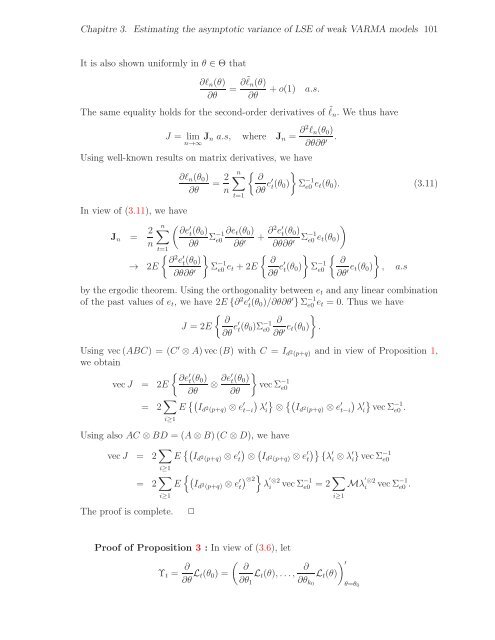THÈSE Estimation, validation et identification des modèles ARMA ...
THÈSE Estimation, validation et identification des modèles ARMA ...
THÈSE Estimation, validation et identification des modèles ARMA ...
Create successful ePaper yourself
Turn your PDF publications into a flip-book with our unique Google optimized e-Paper software.
Chapitre 3. Estimating the asymptotic variance of LSE of weak V<strong>ARMA</strong> models 101<br />
It is also shown uniformly in θ ∈ Θ that<br />
∂ℓn(θ)<br />
∂θ = ∂˜ ℓn(θ)<br />
+o(1) a.s.<br />
∂θ<br />
The same equality holds for the second-order derivatives of ˜ ℓn. We thus have<br />
J = lim<br />
∂θ∂θ ′<br />
n→∞ Jn a.s, where Jn = ∂2 ℓn(θ0)<br />
Using well-known results on matrix derivatives, we have<br />
n<br />
<br />
∂ℓn(θ0) 2 ∂<br />
=<br />
∂θ n ∂θ e′ t (θ0)<br />
<br />
t=1<br />
.<br />
Σ −1<br />
e0 <strong>et</strong>(θ0). (3.11)<br />
In view of (3.11), we have<br />
Jn = 2<br />
n<br />
′ ∂e t (θ0)<br />
n ∂θ<br />
t=1<br />
Σ−1<br />
∂<strong>et</strong>(θ0)<br />
e0<br />
∂θ ′ + ∂2e ′ t (θ0)<br />
Σ−1<br />
∂θ∂θ ′ e0 <strong>et</strong>(θ0)<br />
<br />
2 ′ ∂ e t (θ0)<br />
→ 2E<br />
∂θ∂θ ′<br />
<br />
Σ −1<br />
e0 <strong>et</strong><br />
<br />
∂<br />
+2E<br />
∂θ e′ t (θ0)<br />
<br />
Σ −1<br />
<br />
∂<br />
e0<br />
∂θ ′<strong>et</strong>(θ0)<br />
<br />
, a.s<br />
by the ergodic theorem. Using the orthogonality b<strong>et</strong>ween <strong>et</strong> and any linear combination<br />
of the past values of <strong>et</strong>, we have 2E{∂ 2 e ′ t (θ0)/∂θ∂θ ′ }Σ −1<br />
e0 <strong>et</strong> = 0. Thus we have<br />
J = 2E<br />
∂<br />
∂θ e′ t<br />
(θ0)Σ −1<br />
e0<br />
∂<br />
∂θ ′<strong>et</strong>(θ0)<br />
<br />
.<br />
Using vec(ABC) = (C ′ ⊗A)vec(B) with C = Id2 (p+q) and in view of Proposition 1,<br />
we obtain<br />
′ ∂e<br />
vecJ = 2E<br />
t(θ0)<br />
∂θ ⊗ ∂e′ <br />
t(θ0)<br />
vecΣ<br />
∂θ<br />
−1<br />
e0<br />
= 2 <br />
E Id2 (p+q) ⊗e ′ ′<br />
t−i λ i ⊗ Id2 (p+q) ⊗e ′ ′ −1<br />
t−i λ i vecΣe0 .<br />
i≥1<br />
Using also AC ⊗BD = (A⊗B)(C ⊗D), we have<br />
vecJ = 2 <br />
E Id2 (p+q) ⊗e ′ t<br />
i≥1<br />
= 2 <br />
E<br />
i≥1<br />
The proof is compl<strong>et</strong>e. ✷<br />
⊗ Id 2 (p+q) ⊗e ′ t<br />
Id 2 (p+q) ⊗e ′ <br />
⊗2<br />
t λ ′ ⊗2<br />
i vecΣ −1<br />
e0<br />
{λ ′ i ⊗λ ′ i }vecΣ−1<br />
e0<br />
= 2<br />
Proof of Proposition 3 : In view of (3.6), l<strong>et</strong><br />
Υt = ∂<br />
∂θ Lt(θ0)<br />
<br />
∂<br />
= Lt(θ),...,<br />
∂θ1<br />
∂<br />
Lt(θ)<br />
∂θk0<br />
i≥1<br />
′<br />
Mλ ′ ⊗2<br />
i vecΣ −1<br />
e0 .<br />
θ=θ0
















